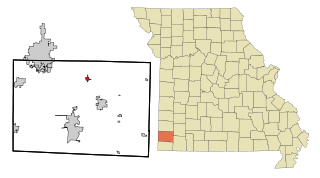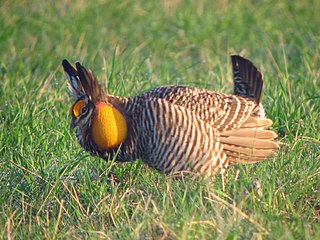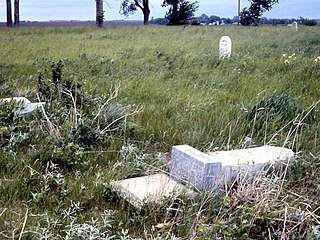Related Research Articles

Prairies are ecosystems considered part of the temperate grasslands, savannas, and shrublands biome by ecologists, based on similar temperate climates, moderate rainfall, and a composition of grasses, herbs, and shrubs, rather than trees, as the dominant vegetation type. Temperate grassland regions include the Pampas of Argentina, Brazil and Uruguay, and the steppe of Ukraine, Russia and Kazakhstan. Lands typically referred to as "prairie" tend to be in North America. The term encompasses the area referred to as the Interior Lowlands of Canada, the United States, and Mexico, which includes all of the Great Plains as well as the wetter, hillier land to the east.

Temperate grasslands, savannas, and shrublands is a terrestrial biome defined by the World Wide Fund for Nature. The predominant vegetation in this biome consists of grass and/or shrubs. The climate is temperate and ranges from semi-arid to semi-humid. The habitat type differs from tropical grasslands in the annual temperature regime as well as the types of species found here.

Diamond is a city in north central Newton County, Missouri, United States, located southeast of Joplin. The population was 902 at the 2010 census. It is part of the Joplin, Missouri, Metropolitan Statistical Area. Diamond is primarily renowned as the birthplace of George Washington Carver.

The greater prairie chicken or pinnated grouse, sometimes called a boomer, is a large bird in the grouse family. This North American species was once abundant, but has become extremely rare and extirpated over much of its range due to habitat loss. Conservation measures are underway to ensure the sustainability of existing small populations. One of the most famous aspects of these creatures is the mating ritual called booming.

Rangelands are grasslands, shrublands, woodlands, wetlands, and deserts that are grazed by domestic livestock or wild animals. Types of rangelands include tallgrass and shortgrass prairies, desert grasslands and shrublands, woodlands, savannas, chaparrals, steppes, and tundras. Rangelands do not include forests lacking grazable understory vegetation, barren desert, farmland, or land covered by solid rock, concrete and/or glaciers.

Tallgrass Prairie National Preserve is a United States National Preserve located in the Flint Hills region of Kansas, north of Strong City. The preserve protects a nationally significant example of the once vast tallgrass prairie ecosystem. Of the 400,000 square miles (1,000,000 km2) of tallgrass prairie that once covered the North American continent, less than 5% remains, primarily in the Flint Hills. Since 2009, the preserve has been home to the Tallgrass Prairie bison herd.

The tallgrass prairie is an ecosystem native to central North America. Historically, natural and anthropogenic fire, as well as grazing by large mammals provided periodic disturbances to these ecosystems, limiting the encroachment of trees, recycling soil nutrients, and facilitating seed dispersal and germination. Prior to widespread use of the steel plow, which enabled large scale conversion to agricultural land use, tallgrass prairies extended throughout the American Midwest and smaller portions of southern central Canada, from the transitional ecotones out of eastern North American forests, west to a climatic threshold based on precipitation and soils, to the southern reaches of the Flint Hills in Oklahoma, to a transition into forest in Manitoba.

The Midewin National Tallgrass Prairie (MNTP) is a tallgrass prairie reserve and similarly preserved as United States National Grassland operated by the United States Forest Service. The first national tallgrass prairie ever designated in the U.S. and the largest conservation site in the Chicago Wilderness region, it is located on the site of the former Joliet Army Ammunition Plant between the towns of Elwood, Manhattan and Wilmington in northeastern Illinois. Since 2015, it has hosted a conservation herd of American bison to study their interaction with prairie restoration and conservation.

The Joseph H. Williams Tallgrass Prairie Preserve, in Osage County, Oklahoma near Foraker, Oklahoma, is the largest protected tract of tallgrass prairie in the world. Managed by The Nature Conservancy, the preserve contains 39,650 acres (160 km2) owned by the Conservancy and another 6,000 acres (24 km2) leased in what was the original tallgrass region of the Great Plains that stretched from Texas to Manitoba.

Prairie restoration is a conservation effort to restore prairie lands that were destroyed due to industrial, agricultural, commercial, or residential development. The primary aim is to return areas and ecosystems to their previous state before their depletion.

The shortgrass prairie is an ecosystem located in the Great Plains of North America. The two most dominant grasses in the shortgrass prairie are blue grama and buffalograss, the two less dominant grasses in the prairie are greasegrass and sideoats grama. The prairie was formerly maintained by grazing pressure of American bison, which is the keystone species. Due to its semiarid climate, the shortgrass prairie receives on average less precipitation than that of the tall and mixed grass prairies to the east.
The Hayden Prairie State Preserve is a 240-acre (97 ha) tallgrass prairie located in Howard County, Iowa. It is a National Natural Landmark managed by the Iowa Department of Natural Resources. Located close to the northern border of the state of Iowa, the nearest towns are Chester and Lime Springs.

American Prairie is a prairie-based nature reserve in Central Montana being developed as a private project of the American Prairie Foundation (APF). This independent non-profit organization is creating a wildlife conservation area that aims to cover over 3 million acres (12,000 km2) through a combination of both private and public lands to restore a mixed grass prairie ecosystem with migration corridors and native wildlife.
The Weston Cemetery Prairie is a mesic tallgrass prairie remnant, described variously as being 5.61 acres or 3.2 acres in size, located 0.5 miles (0.8 km) east of Weston, Illinois, an unincorporated community in McLean County, Illinois. Weston Cemetery Prairie is a remnant of the vast tallgrass, black soil prairies that once covered more than 13 million acres of Illinois. This cemetery prairie is listed as a Category I site on the Illinois Natural Areas Inventory and is actively managed with periodic burns and exotic species control efforts.
The Prairie Ridge State Natural Area is a 4,101-acre (1,660 ha) collaborative natural area managed by the Illinois Department of Natural Resources. It is managed for the benefit of endangered, threatened, watch list, and area sensitive species associated with the tallgrass prairie habitat of south-central Illinois, especially the greater prairie chicken. The natural area is split between land parcels in Jasper County and Marion County, in the U.S. state of Illinois.

Cayler Prairie State Preserve is a 160-acre land parcel of tallgrass prairie located in the northwest region of the U.S. state of Iowa in Dickinson County near Spirit Lake. It is a National Natural Landmark.

Golden Prairie is a 630-acre (2,500,000 m2) tallgrass prairie named for its proximity to Golden City in the U.S. state of Missouri. The core 320-acre (1,300,000 m2) area is a National Natural Landmark.

Cemetery prairies are remnants of native North American prairie that survive on land set aside by settlers as burial grounds. These places were thus left unplowed and largely undisturbed, such that the cemeteries became de facto nature preserves.
The Diamond Grove Prairie Conservation Area is an 852-acre natural area located adjacent to the Missouri municipality of Diamond. The conservation area is characterized by rolling tallgrass prairie and prairie savanna. The conservation area is located relatively near, although not adjacent to, the George Washington Carver National Monument. It shows the landscape that was familiar to the Carver family group in the 1860s, the time of the American Civil War.
References
- 1 2 3 "Where We Work: About MPF Prairies". moprairie.org. Missouri Prairie Foundation. Retrieved May 6, 2023.
- ↑ "Carver Prairie". moprairie.org. Missouri Prairie Foundation. Retrieved May 6, 2023.
- ↑ Pfeil, Alyse (April 8, 2023). "Missouri Prairie Foundation attracts crowd for native plant sale". Columbia Missourian . Columbia, Mo. Retrieved May 6, 2023.